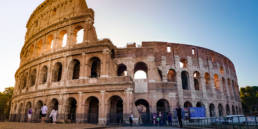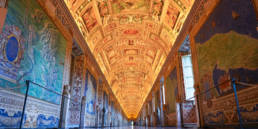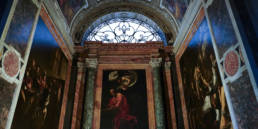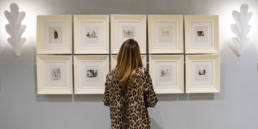A very incomplete hint at some of the treasures of Medieval Rome written during a month-long stay in Rome in October 2004, when I started this blog.
The Mausoleum of Santa Costantia

Built by Costantia, the daughter of Constantine, in 337-54. Her big porphyry sarcophagus, now in the Vatican museums, was located in a niche here and is now replaced by an ugly copy. The circular building has a donut of mosaics with a distinctly pagan character. They are decorative rather than figurative, alternating geometric with vine motifs populated by elongated and somewhat awkward putti. The two bays closest to Constantia’s sarcophagus are more detailed, with exotic animals, mirrors, and a greater use of coloured tesserae.
My guidebook wrongly said that this was open monday morning, so i was sadly surprised to find it closed. I stopped by the parish office to chat up the priest, never asking him directly to open it… and he just offered to unlock it and asked me to close it when i left. He said there had been theives so they didn’t leave it open any more – how sad. It was fabulous to have the mausoleum mostly to myself (i let in a few german tourists), though i suspect that it is never all that crowded because it’s pretty far off the beaten track. It is however worth the trip (which is not that arduous because the express bus is very… express) to see how these very early christian mosaics retain pagan motifs and style but take on christian function.

Located in the modern residential area of Nomentana – take the express bus #60 to get there.
San Clemente
While this church’s present architectural form dates to 1108, there are two lower levels dating from the 9th and 1st centuries! First you can admire the rather coherant medieval whole of this basilican plan church, with a fabulous Cosmatesque floor (=inlaid marble work) and choir area, and a resplendant mosaic representing christ as the tree of life. Look closely or with binoculars and you will see some very cute animals at the bottom of this tree.

Through the sacristy on the right you can enter the lower churches. The first level below ground contains some 9th century frescoes though you can’t see much due to restoration and condition. Try to orient yourself so that you can take in the basilican plan that was already present at this level.
It is then possible to go down a further level, into a series of Roman spaces (unclear if these were domestic spaces?). Here it is easy to get lost and not of any particular artistic note.
Located near the Colosseum, open 9-12:30 and 15-18, there is an entrance fee for the lower church.
Church of Santa Prassede
My textbook, because of an amusing but grave grammatical error, implies that Santa Prassede was killed with a sponge, which of course is not true, but now I’ll never forget it. The statue in the photo shows her with the blood-soaked sponge with which she wiped up the blood of other martyrs before becoming one herself.

Entry to this church is through an unassuming side entrance flanked as usual by beggars. As usual, i walked to the far end of the nave to get a complete look. The apse and triumphal arch are covered in very fine 9th century mosaics, while the chapel of St. Zenone, on the right, is slightly later (the detail photo shows the largish tesserae in this chapel). The mosaics are worth looking at with binoculars.

Open regular church hours, free.
For further information: there is a scholarly discussion of this church in this book:
Rome 1300: on the path of the pilgrim
The Cloister of San Giovanni in Laterano
There is a medieval cloister with Cosmatesque twisted columns inlaid with mosaics (entry 2 euros) at the side of this church.
Sign up to receive future blog posts by email
Alexandra Korey
Alexandra Korey aka @arttrav on social media, is a Florence-based writer and digital consultant. Her blog, ArtTrav has been online since 2004.
Related Posts
April 9, 2019
A Restoration Lab Tour and Caravaggio in Rome
February 1, 2017




